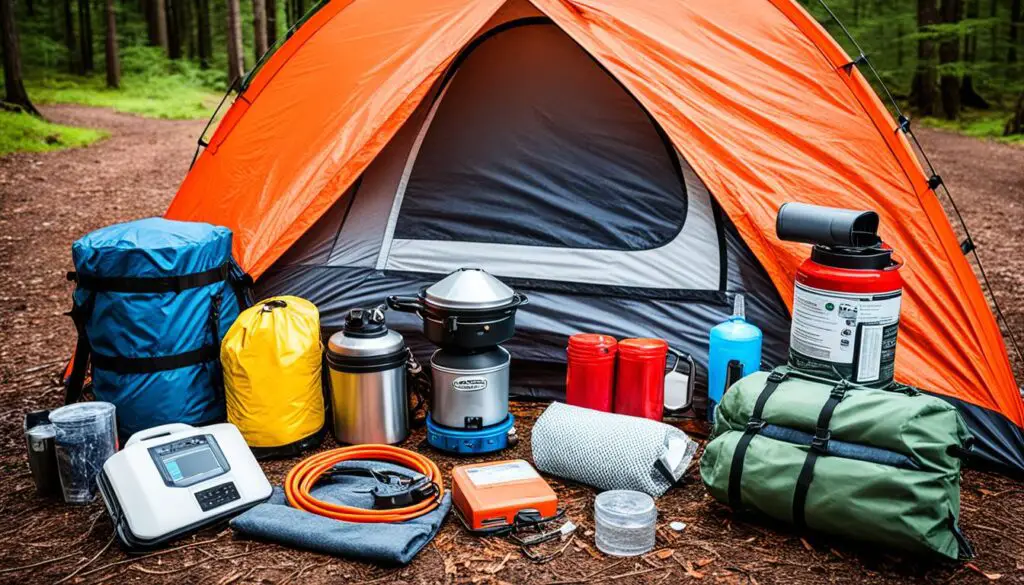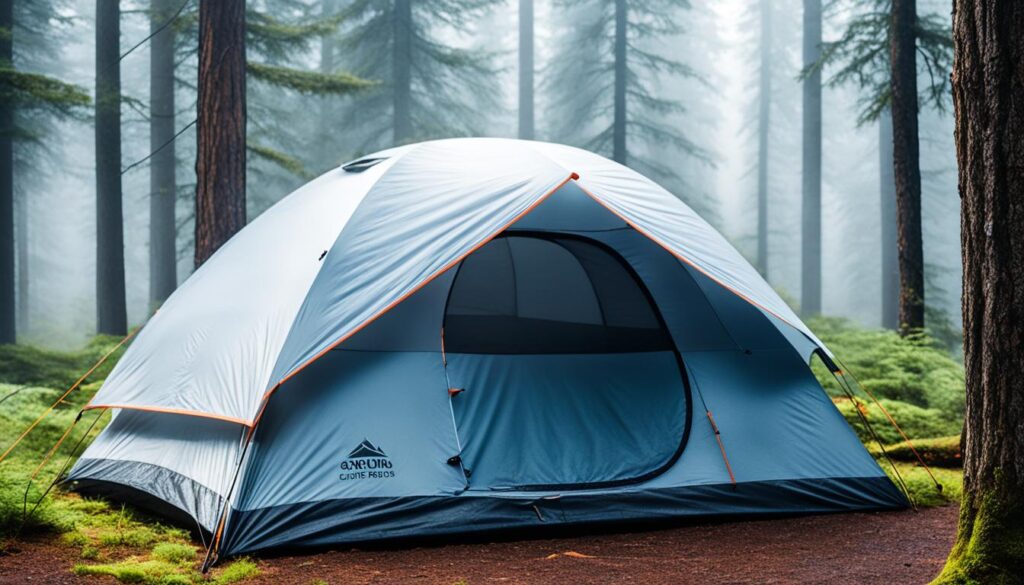Prevent Condensation Car Camping
Being a car camping enthusiast, I understand the need to avoid excess moisture. It can ruin your trip and cause issues like mold and damage. In this guide, I will help you stay dry and comfortable during your adventures.
I will explain why condensation happens and how to stop it. With tips on ventilation and insulation, I’ll make sure your car is a cozy space. This advice is perfect for all kinds of camping trips, keeping you comfy and dry.
Understanding Condensation in Your Vehicle
Condensation is a big issue for car campers. Knowing what causes it helps stop it. It happens when warm, wet air meets a cool surface. Normally, this is because the car’s inside is colder, making the air lose its moisture.
What Causes Condensation?
Many things can make condensation show up in your car:
- Humidity levels: High humidity, from outside or breathing, adds more moisture to the air.
- Temperature changes: Quick cool-downs make the air’s moisture turn into water on cold surfaces.
- Lack of ventilation: Not enough fresh air stops the moisture from leaving, leading to more condensation.
The Dangers of Excess Moisture
Too much condensation can cause serious issues:
- Mold and mildew growth: It can create a perfect place for mold and mildew, bad for health and your car’s look.
- Equipment damage: Moisture harms electronics, camping stuff, and gear inside the car.
- Discomfort and reduced visibility: It makes windows foggy, making it hard to see and the car feel wet and yucky inside.
Knowing what causes condensation and its dangers helps. This way, you can stop too much moisture. Then, car camping becomes more fun and less of a hassle.
Prevent Condensation Car Camping: Essential Preparations
Proper preparation prevents condensation when car camping. Take the right steps before your trip for a dry and comfy adventure. Below, you’ll find key steps to keep moisture out and ensure a great camping time.
Pre-Trip Inspection and Planning
Start by checking your vehicle well. Look for areas where moisture might get in, like cracks or openings. Make sure your car’s vents work well.
Packing the Right Gear
Think about what gear helps control moisture. Pack a dehumidifier or desiccant bags to soak up extra humidity. Include bedding and clothes that breathe to avoid moisture buildup.
Creating a Moisture Control Checklist
Make a list of everything you’ll need to keep moisture under control. This could be window shades, special insulation, or other gear. Being well-organized helps ensure your car camping stays dry and cozy.
| Pre-Trip Planning Essentials | Packing Checklist |
|---|---|
|
|
By completing these key tasks, you’re on your way to a condensation-free and comfortable car camping trip.

Ventilation Strategies for Moisture Control
Keeping your car dry during camping trips is key. You need to have good ventilation to control condensation. Effective airflow and special tools that absorb moisture are important. They help keep your car comfortable on your adventures.
Creating Airflow Inside Your Car
To stop condensation, keep air moving in your car. This is done in several ways:
- Open windows and sunroofs when parked to let air flow.
- Use fans, whether they’re portable or part of your car’s system, to keep air moving.
- Place vents well to guide airflow and improve ventilation.
- Think about adding more vents or updating your system for better air flow.
Using Desiccants and Dehumidifiers
Desiccants and dehumidifiers also play a big role in keeping your car dry. They pull excess moisture from the air. This makes your car’s inside feel drier and more comfy.
| Desiccants | Dehumidifiers |
|---|---|
| Silica gel packets or bags that absorb moisture from the air | Compact, battery-powered devices that actively remove moisture from the air |
| Reusable and easily replaced | Require electrical power or rechargeable batteries |
| Effective for small to medium-sized spaces | Suitable for larger spaces and higher moisture levels |
So, by wisely using vehicle ventilation and adding desiccants and dehumidifiers, you get a great system. This setup helps handle moisture well. It makes sure your car stays dry and cozy during camping.
Insulating Your Car for Drier Conditions
Insulating your car keeps it dry by controlling condensation. It maintains a steady temperature. This way, it stays drier and more comfy for your winter car camp trips.
Choosing the Right Insulation Materials
The material you pick for insulating your car in winter is very important. Experts say sleeping in cars below -30°F is too cold. So, choosing the right insulation helps keeps things warm and prevents condensation.
Reflectix is a top choice for car insulation. It bounces heat back. Yet, it might cause condensation issues because it blocks moisture and heat. To prevent this, think through your insulation plan. Don’t add too much to keep heat moving and stop condensation.
Wool blankets are another good option. They regulate temperature well without trapping moisture like a vapor barrier. In camping and RVs, the best insulation for winter car camping includes heavy sleeping bags. Look for bags with 0°F or 15°F ratings for the coziest winter nights in your car.
Finding the right balance between thermal regulation and moisture control is key. It keeps your car dry and welcoming all winter. Choosing your insulation wisely leads to a great winter car camping trip.
Conclusion
Stopping condensation while car camping is key. It keeps you dry and comfy. You need to know why condensation happens. Then, use different ways to fight it. This way, your camping trips will be great.
To keep your spot dry, try good airflow, special drying stuff, and keeping the heat in. These methods stop too much moisture. So, your camping time is fun and dry.
Prepare well to stop condensation. This makes your camping trips memorable. Follow these steps. Your journey will be dry, cozy, and free of moisture problems.
FAQ
What causes condensation in my car while car camping?
Condensation happens when warm, wet air hits a cool surface. This might be the car’s windows. It happens more when the car’s inside gets cooler.
What are the dangers of excess moisture in my car while car camping?
Too much moisture might grow mold and mildew. This can hurt your gear and make camping not fun. It can also damage your car’s insides over time.
How can I prepare my car for a condensation-free car camping trip?
To avoid condensation, check your car, bring the right stuff, and plan ahead. Make sure your car gets enough air, use drying agents, and keep it warm with insulation.
What ventilation strategies can I use to control moisture in my car?
Good airflow is key to avoid condensation. Open windows and use fans. Placing vents smartly helps too. Drying agents like desiccants and dehumidifiers absorb extra moisture.
How does insulating my car help prevent condensation during car camping?
Insulation keeps your car’s temperature steady. This reduces moisture. With the right materials, your car stays dry and cozy during camping.
What are some key keywords related to preventing condensation while car camping?
Important words include car camping, stopping condensation, keeping dry, trips at night, mold and mildew, damage to gear, getting ready before, ventilation, drying agents, car insulation, staying warm and dry.
